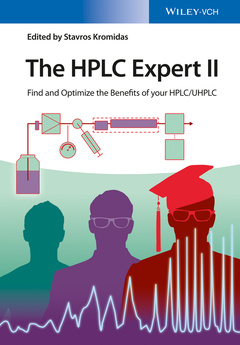Description
The HPLC Expert II
Find and Optimize the Benefits of your HPLC / UHPLC
Coordinator: Kromidas Stavros
Language: English
Subject for The HPLC Expert II:
Keywords
hplcexpert; uhplc; structure; contributors; foreword; list; capable; iwant; method; hplc; routine; report; brief; potential; fully; references part; modern; uhplc system; external; issue; minor matter
384 p. · 17x24.9 cm · Hardback
Description
/li>Contents
/li>Biography
/li>
List of Contributors xiii
Foreword xv
The Structure of “The HPLC-Expert 2” xvii
1 When Should I UseMy UHPLC as a UHPLC? 1
Stavros Kromidas
1.1 Introduction 1
1.2 What Do IWant to Achieve and What Is a UHPLC Capable of? 2
1.3 What Is Required from an HPLC Method? 3
1.4 The UHPLC in Routine Use – A Brief Report 17
1.5 How Can the Potential of UHPLC Effectively Be Fully Exploited? (See Also Chapters 2, 3, and 9) 20
1.6 Summary and Outlook 22
References 25
Part I Hardware and Software, Separation Modes, Materials 27
2 The Modern HPLC/UHPLC Device 29
2.1 The Modern HPLC/UHPLC System 29
Steffen Wiese and Terence Hetzel
Acknowledgment 50
References 50
2.2 TheThermostate of Columns – A Minor Matter 52
Michael Heidorn and Frank Steiner
3 The Issue of External Band Broadening in HPLC/UHPLC Devices 73
Monika Dittmann
3.1 Introduction 73
3.2 Theoretical Background 74
3.3 Extracolumn Dispersion in (U)HPLC Systems 78
3.4 Impact of External Contributions in Different Application Areas 90
3.5 Optimization of HPLC/UHPLC Systems 94
3.6 Conclusions 97
References 98
4 The Gradient; Requirements, Optimal Use, Hints, and Pitfalls 101
Frank Steiner
4.1 Instrumental Influences in Gradient Elution – An Overview 101
4.2 Gradient Elution Technology and How to Systematically Characterize Gradient Instrumentation 117
References 169
5 Requirements of LC-Hardware for the Coupling of Different Mass Spectrometers 171
Terence Hetzel, Thorsten Teutenberg, Christoph Portner, and Jochen Tuerk
5.1 Introduction 171
5.2 From Target Analysis to Screening Approaches 171
5.3 What Should Be Considered for UHPLC/MS Hyphenation? 173
5.4 Target Analysis Using Triple-Quadrupole Mass Spectrometry 178
5.5 Screening Approaches Using LC-MS 185
5.6 Miniaturization – LC-MS Quo Vadis? 189
References 192
6 2D chromatography – Opportunities and limitations 193
Thorsten Teutenberg and Juri Leonhardt
6.1 Introduction 193
6.2 Why Two-Dimensional HPLC? 193
6.3 Peak Capacity of One- and Two-Dimensional Liquid Chromatography 195
6.4 Modulation 200
6.5 Practical Problems of Online LC × LC 203
6.6 Development of a Miniaturized LC× LC System 204
6.7 Real Applications 207
6.8 Advantages of the MS/MS Functionality 211
6.9 General Comments to Specific Aspects of an LC × LC System 211
6.10 Method Development and Gradient Programming 215
6.11 Presentations of the Instrument Manufacturers (in Alphabetical Order) 215
6.12 2D LC – Quo Vadis? 217
References 219
7 Materials in HPLC and UHPLC – What to Use for Which Purpose 223
Tobias Fehrenbach and Steffen Wiese
7.1 Introduction 223
7.2 Requirements for Materials in UHPLC 225
7.3 Flow Paths in UHPLC Systems 227
7.4 Low-Pressure Flow Path 229
7.5 High-Pressure Flow Path 231
7.6 When and Why Can an Inert UHPLC System Be Required? 248
References 261
Part II Experience Reports, Trends 269
8 What a Software has to Possess in Order to Use the Hardware Optimally 271
Arno Simon
8.1 Functionality and Handling 271
8.2 Data Exchange 277
8.3 From PCs Scalability to Global Installation 278
9 Aspects of the Modern HPLC Device – Experience Report of an Operator 281
Steffen Wiese and Terence Hetzel
9.1 Introduction 281
9.2 Determination of the Gradient Delay Volume 281
9.3 High-Throughput Separations 285
9.4 Method Transfer between UHPLC Systems of Different Manufacturers 287
9.5 Application of Elevated Temperatures 290
9.6 Large-Volume Injection (LVI) 293
9.7 UHPLC Separation with 1mm ID Columns 296
Acknowledgment 299
References 299
10 Experiences of an Independent Service Engineer – Hints and Recommendations for an Optimal Operation of Agilent and Waters-Devices 301
Siegfried Chroustovsky
10.1 Introduction 301
10.2 The Degasser, Principles 301
10.3 The Pump, Principles 303
10.4 The Autosampler, Principles 306
10.5 The UV Detector, Principles 308
11 The Analyte, the Question, and the UHPLC – The Use of UHPLC in Practice 311
Stefan Lamotte
11.1 Introduction 311
11.2 When Does It Make Sense to Use UHPLC and When Should I Better Use Conventional HPLC? 311
11.3 Dissolution Tests in Pharmaceutical Industry 313
11.4 Method Development and Optimization 314
11.5 Typical “Classical” Liquid Chromatographic Analysis 314
11.6 Fast (Most Second) Dimension of Multidimensional Chromatography 315
11.7 Separation of (Bio)polymers 316
11.8 Process Analysis (PAT) 316
11.9 Conclusion 316
References 316
12 Report of Device Manufacturers – Article by Agilent, Shimadzu, and ThermoScientific 319
12.1 Agilent Technologies 319
Jens Trafkowski
References 328
12.2 HPLC Current Status and Future Development 328
Björn-Thoralf Erxleben
12.3 Thermo Fisher Scientific, Germering 334
Frank Steiner
About the Authors 349
Index 355




